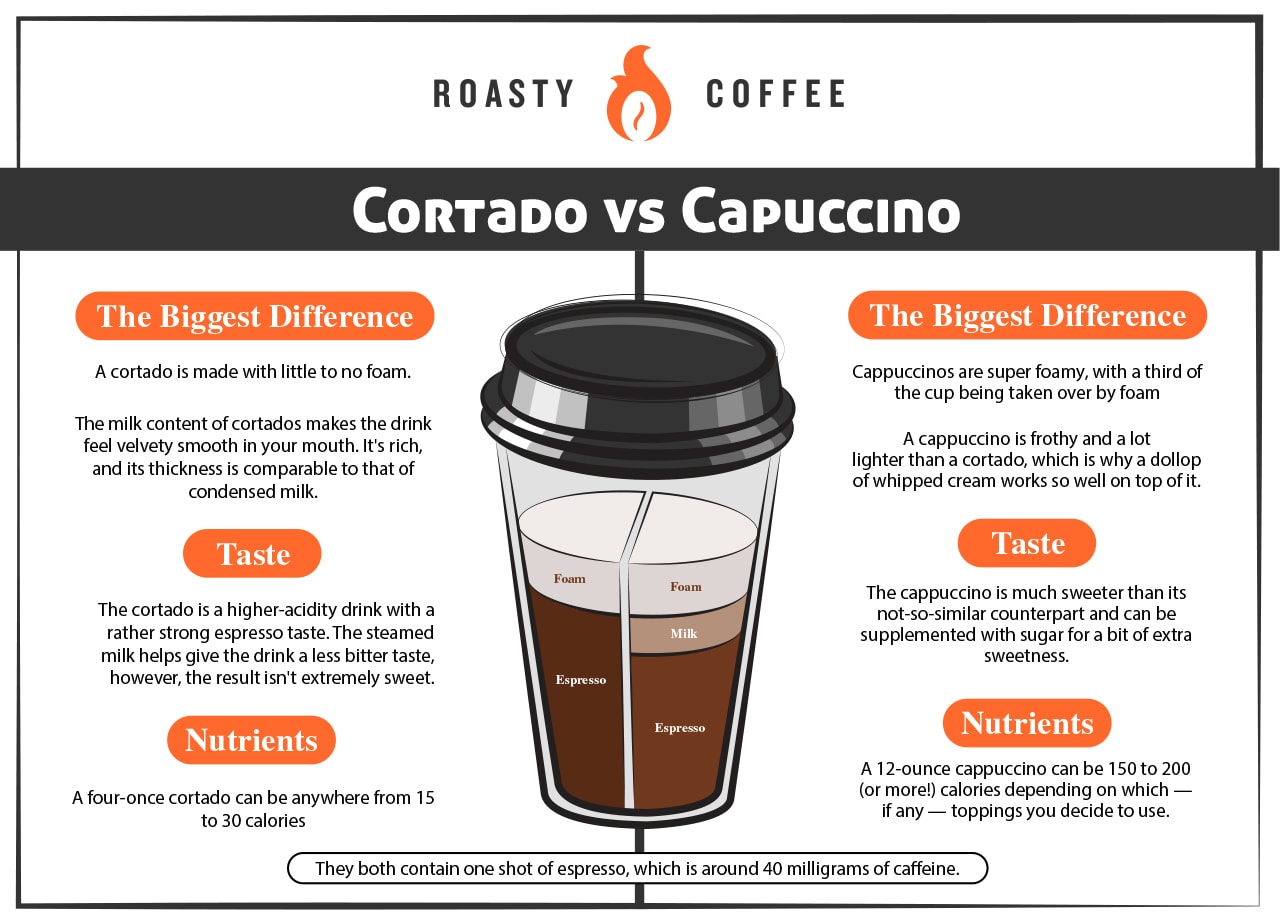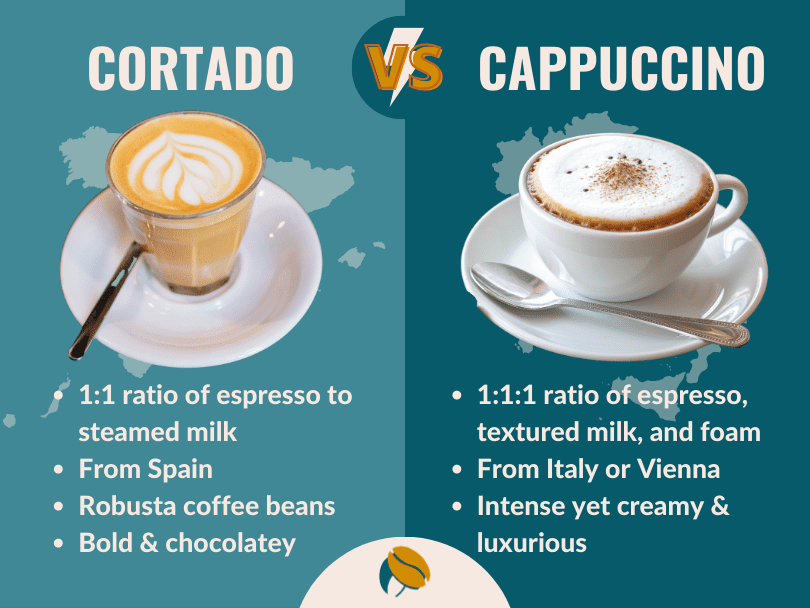Cortado Vs. Cappuccino: What's The Difference? A Coffee Guide
Do you often find yourself staring at the coffee shop menu, overwhelmed by the choices? Understanding the nuances between a cortado and a cappuccino can transform your coffee experience, opening a world of flavor and texture.
As you navigate the diverse landscape of espresso-based beverages, the cortado and cappuccino stand out as two popular choices. However, a deeper look reveals significant differences that extend far beyond their appearances. A cappuccino, for instance, is known for its frothy texture, achieved through a generous layer of foamed milk, whereas a cortado presents a more understated profile. The very essence of these drinks, from their preparation to their cultural significance, distinguishes them as unique offerings.
To further illuminate the specifics, let's dissect the key attributes and create a simple comparison table.
| Feature | Cortado | Cappuccino |
|---|---|---|
| Espresso to Milk Ratio | Equal parts espresso and steamed milk. | 1:3 ratio of espresso, steamed milk, and frothed milk. |
| Milk Texture | Steamed milk, not textured or frothed. | Steamed milk and a thick layer of frothed milk. |
| Serving Size | Typically served in a small glass (4-6 ounces). | Served in a larger cup (6-8 ounces or more). |
| Flavor Profile | Bold, intense coffee flavor with a hint of sweetness. | Creamy, airy texture with a balance of coffee and milk. |
| Texture | Silky, velvety mouthfeel due to the integration of milk with espresso. | Lighter texture due to the frothed milk layers. |
| Caffeine Content | Typically, a single or double shot of espresso, (68mg caffeine per shot). | Typically, a single or double shot of espresso, (68mg caffeine per shot). |
| Calories | Varies based on milk used. Typically, less than a cappuccino. | Varies based on milk used and if sweeteners are added. |
| Sweeteners | Sweeteners are sometimes added. | Sweeteners are sometimes added. |
For more detailed information on coffee preparation and its origin, see: Wikipedia.
The primary difference, which becomes immediately noticeable when comparing the cortado and cappuccino, is the presence or absence of milk foam. The cortado, originating in Spain, is made with freshly brewed espresso "cut" with an equal portion of steamed milk. This approach results in a bold coffee flavor, allowing the espresso to be the star, but softened by the milk's subtle sweetness. The milk in a cortado isnt textured or frothed; it's simply steamed, blending seamlessly with the espresso to create a smooth, balanced drink. In contrast, the cappuccino, hailing from Italy, is characterized by a thick layer of foamed milk, often two to three times the amount of espresso. This texture is a defining characteristic, giving the cappuccino its airy, light, and creamy feel.
When the focus shifts to taste, the contrast becomes even more apparent. Because the cortado uses less milk, it delivers a more robust and intense coffee flavor. The coffee's character takes precedence, its inherent notes brought to the forefront, with the milk gently softening the edges. This approach creates a silky, rich texture that envelops the palate, leaving a pleasant aftertaste that lingers. The cappuccino, however, offers a lighter texture. The generous layer of frothed milk provides a creamy, airy experience, where the coffee flavor is less dominant. In this drink, the espresso plays a supporting role to the milk's frothy performance.
The serving sizes also highlight their distinct profiles. Cortados are typically served in small glasses, around 4-6 ounces. This smaller size emphasizes the beverage's intensity and balance. The drink is meant to be enjoyed quickly, allowing the coffee's flavors to be savored. Cappuccinos, on the other hand, come in larger cups, usually ranging from 6-8 ounces or more. This larger size supports the voluminous nature of the drink and the focus on the texture of the milk foam.
The origins of each drink further distinguish them. The cortado's roots trace back to the early 1960s in Spain, where it emerged as a way to temper the strength of espresso. The word "cortado" itself, derived from the Spanish verb "cortar," meaning "to cut," perfectly describes its purpose: to cut through the coffees intensity with milk. The cappuccino, on the other hand, has a rich history in Italy, where it is a staple breakfast drink, often consumed with pastries. Its iconic status, with the milk foam often embellished with latte art, reflects a long-standing tradition and global popularity.
Both drinks share some common ground. Both cortados and cappuccinos begin with a single or double shot of espresso, providing the base of their caffeine content and coffee flavor. Both also contain similar nutrients, such as protein, calcium, and vitamin D, which vary slightly depending on the type of milk used. However, the different ratios and techniques lead to significantly different experiences.
The choice between a cortado and a cappuccino often depends on your preference for coffee intensity versus a creamier experience. If you crave a robust, bold coffee flavor, with a balanced profile, then the cortado is your optimal choice. Its approach to espresso-milk harmony is clean and straightforward, making the coffee the main event. On the other hand, if you're seeking a more delicate and comforting drink, where the focus is on the airy texture and a balance of coffee and milk, the cappuccino is a perfect selection. Its richer texture and emphasis on milk foam offer a more gentle coffee experience.
While these two drinks are distinct, they both contribute to the diverse and exciting world of coffee beverages. The differences between a cortado, a latte, and a cappuccino are clear and present. While both cortado and flat white coffee use steamed milk, the texture and quantity of milk varies significantly, enhancing the different overall experience. The cortado and cappuccino exemplify how seemingly similar ingredients espresso and milk can create distinct and delightful coffee experiences.
Understanding the differences between these espresso drinks can help you elevate your coffee choices. Whether you are a seasoned coffee aficionado or a curious newcomer, experimenting with cortados and cappuccinos will enrich your appreciation for the art of coffee. Explore the menu with confidence, knowing exactly what awaits you.
Beyond the cortado and the cappuccino, there are many variations to explore. The latte offers a sweeter and milkier experience. The flat white offers a blend of espresso and milk with a velvety texture. The Macchiato provides a balance between espresso's intensity and milk's creaminess. And the mocha merges espresso with chocolate, providing a more complex flavor. Each drink offers a unique take on the classic espresso experience. Exploring these drinks opens up a world of possibilities, and challenges your taste buds. Discovering these different drinks provides a journey in itself.


